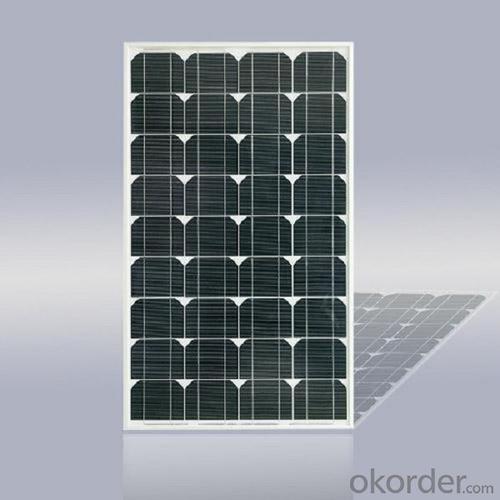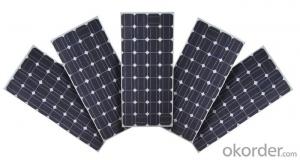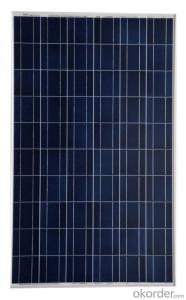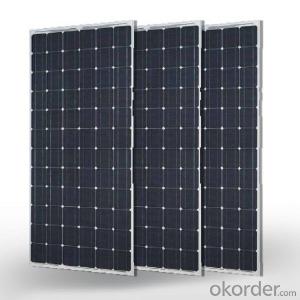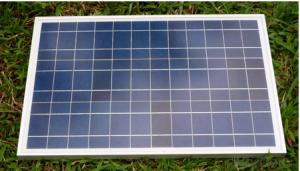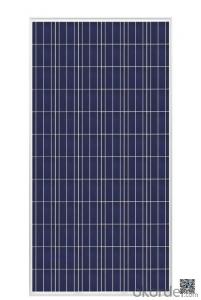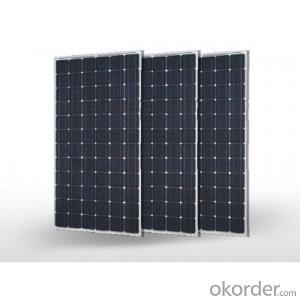Most Efficient Flexible Solar Panels - 250W High Efficiency Solar Panel Module in China
- Loading Port:
- Shanghai
- Payment Terms:
- TT OR LC
- Min Order Qty:
- 2500 watt
- Supply Capability:
- 15000 watt/month
OKorder Service Pledge
OKorder Financial Service
You Might Also Like
Specification
1.Structure of Monocrystalline Solar Module for 250W Series Description:
Monocrystalline Solar Module for M125-15W
High efficiency crystalline solar cell. Even if under the weak light, the solar module can produce maximum power output.
II Tempered glass (toughened glass): Anti-reflecting coating and high transmission rate glass increase the power output and mechanical strength of solar module.
III EVA and TPT: Using high quality EVA and TPT to prevent destroying and water.
IV AI frame: Without screw, rner connection. 6 holes on the frame can be installed easily.
V Junction box: Multi function junction box with water proof.
VI Long lifetime: ≥25 years; Less power decrease.
VII Good performance of preventing from atrocious weather such as wind and hails.
VIII Resisting moisture and etching effectively, not effected by geology.
IX The certificate issued by international authority: UL, TUV, IEC, CE.

PERFORMANCE
- High effi ciency, multicrystalline silicon solar cells with high transmission and textured glass deliver a module effi ciency of up to 16.0%,
minimizing installation costs and maximizing the kWh output of your system per unit area.
- Tight positive power tolerance of 0W to +5W ensures you receive modules at or above nameplate power and contributes to minimizing
module mismatch losses leading to improved system yield.
RELIABILITY
- Tests by independent laboratories prove that Solar modules:
Fully conform to certifi cation and regulatory standards.
Withstand wind loads of up to 2.4kPa and snow loads of up to 5.4kPa, confi rming mechanical stability.
Successfully endure ammonia and salt-mist exposure at the highest severity level, ensuring their performance in adverse conditions.
- Q: Ok so i can have a problem i have two 5 watt 2 volt solar panels a 2 volt battery and a 400 watt ac 2 volt dc inverter i believe im only getting 5 watts from from my solar panels thats the equivalent of one is there any way i could get full voltage from my solar panels without theoretically burning my wallet.. please help
- I think you need to take some basic courses on electricity. Usually, 8 volt solar panels are required to charge 2 volt batteries. The voltages of photovoltaic cells are set by the material they are made of, only current changes. If you hook up a 2 V solar panel to a 2 V battery, no current will flow, nothing would get charged. You would need some elaborate DC to DC voltage converters to charge a 2 V battery from 2 V solar panels. Solar panels can be connected in parallel or in series, as you've made the mistake of buying 2 V solar panel, you would have to wire them in series and have a charge controller that could limit the voltage of the charge. Did it ever occur to you that two 5 watt solar panels would not be able to provide the power needed by a 400 watt inverter? You're just running off your battery with your set up. Solar power is expensive power, you can not have solar without burning a hole in your wallet.
- Q: Can solar panels be integrated into building materials?
- Yes, solar panels can be integrated into building materials. This innovative approach, known as building-integrated photovoltaics (BIPV), allows solar panels to be seamlessly incorporated into various architectural elements such as roofs, facades, windows, and even entire building structures. BIPV offers a dual function by serving as both a source of renewable energy and a structural component, enabling buildings to generate sustainable electricity while maintaining aesthetic appeal.
- Q: I contend:As far as the solar panels causing global warming I'll try to explain. If you put a black panel on the ground or on your house and don't connect it to anything, it will absorb solar energy (heat) during daylight and release it at night (radiation). The net heat gain is zero. If you hook up a solar panel in the same place but hook it up to batteries, charge the batteries during sunlight hours and using that energy to electrically heat the home at night. The panels will absorb solar energy during the day but will convert that to electrical energy in the batteries instead of radiating it back into space at night. The result is a net gain in earth's temperature.Right or wrong?
- As far as it goes, you're right: putting up a big black object increases the total amount of energy absorbed from the sun. But that's only part of the story. If you didn't put up the solar panel, the same radiation would hit the earth. The earth already absorbs 2/3 or so of the energy that comes in (albedo .30), so adding even a perfectly black object increases it only by 50%. But it's not even that much, because most of the extra energy absorbed is converted into electricity. Solar panels are about 0-5% efficient, so half of the extra energy is turned into electricity rather than heat. Eventually it's put to use and turned into heat, but that heat was going to come from somewhere else anyway. (Even if it's just powering your DVD player, it turns into heat just the same as if you were using it to heat your house.) If you dig up a gallon of petroleum or fission a microgram of uranium, that's heat introduced into the earth's atmosphere. And these processes are inefficient: between generation and transmission you lose about 75% of the energy, meaning you've introduced 4 times as much energy into the atmosphere as you've actually used. So with a solar panel, you add extra heat to the earth by about 25% of incoming solar radiation, but you've offset external costs by about 45% of incoming solar radiation. The net effect is to cool the earth. And that assumes that the solar panel itself is perfectly black, which isn't the case. Real commercial solar panels have an albedo of about .35, which makes them more reflective than dirt and considerably more reflective than asphalt shingles, which have .03 albedo. In other words, even if you didn't actually use the solar panels for electricity, they'd be cooling the earth just by reflecting energy back into space more than your regular shingles.
- Q: I want to know that if I put solar panels in space if Pluto can recieve energy for iPods and television
- Two problems: ) solar flux. Around Earth, we receive solar energy to the tune of 370 W/m^2 (watts per square metre). In theory, if you have a solar panel of metre by one metre and place it (in space) directly perpendicular to the rays of the sun (meaning = the panel is facing the sun perfectly), you should get 370 watts of power. In practice, the panels are never 00% efficient so that you get less. The flux (just like the intensity of light) drops as the square of the distance increases. Pluto is -- on average -- 39 times further from the Sun, therefore the flux there will be reduced by a fraction of 39^2 = 52 times 370 / 57 = 0.9 W Even with 00% efficiency, you square metre panel will produce less than one watt, once you get it out to Pluto. 2) temperature It is very difficult to built a solar panel (with all the required wire connections) that remains flexible enough at Pluto's temperatures. Temperature drops as the 4th root of the flux (or, to make it easier, the square root of the distance). sqrt(39) = 6.25 Temperature at Pluto = Temperature at Earth / 6.25 (in degrees Kelvin -- also known as Absolute Temperature) At best, temperature around here is 300 K (it is less than that, but 300 makes the calculation easier) 300 / 6.25 = 48 48 K = -225 C = -373 F wires and insulation become very brittle at these temperatures... and one watt of power flowing through the wires will NEVER be enough to warm them up (never mind running the iPod).
- Q: what direction should solar panels face to get the best exposure of the sun.
- The following links is a sun angle calculator which I find very helpful during my days of doing project about solar panel. The calculator will give you the accurate location of the sun. Solar panel work best when it is directly facing the sun. All you have to do is key in your location details and it will provide you with two most important details: azimuth angle and altitude angle. Azimuth angle is the East angle where the Sun is relative to the South while altitude angle is the tilt angle of the solar panel throughout the day. By using these two angles, you will maximize your exposure of solar panels. However, if you are experiencing rainy or cloudy days, horizontally mounted solar panels is the most efficient.
- Q: Can solar panels be used in areas with high levels of shade?
- Solar panels can still be used in areas with high levels of shade, but their efficiency and energy production may be significantly reduced.
- Q: Can solar panels be installed on historical buildings?
- Yes, solar panels can be installed on historical buildings. However, the installation process may require careful planning and consideration to ensure that the historical integrity and architectural significance of the building are not compromised.
- Q: I was watching an idiot abroad, and I saw a family that lived in tent like huts, with no plumbing. And they had a solar panel, now if they can afford it, I know I can. Where do you get cheap ones?
- you okorder . all you have to do is watch the video.
- Q: I'm thinking of doing solar panel but i don't know how much they are i need help! please!
- no one has answered because you asked a question that cannot be answered. It is exactly the same question as how much is a car?. Do you want a passive solar heating panel, a solar electric panel, .5 Volts, ,000,000 BTUs, do you want just the panel or the panel installed and functioning, or what? the answer is between $5 and $5,000,000.
- Q: Home depot has solar panels but they are so expensive? were is the best place to get them?
- It okorder to locate a solar specialist in your area. Be sure to ask them about any state or local tax incentives for installing home solar. This can really drop your costs.
Send your message to us
Most Efficient Flexible Solar Panels - 250W High Efficiency Solar Panel Module in China
- Loading Port:
- Shanghai
- Payment Terms:
- TT OR LC
- Min Order Qty:
- 2500 watt
- Supply Capability:
- 15000 watt/month
OKorder Service Pledge
OKorder Financial Service
Similar products
Hot products
Hot Searches
Related keywords


